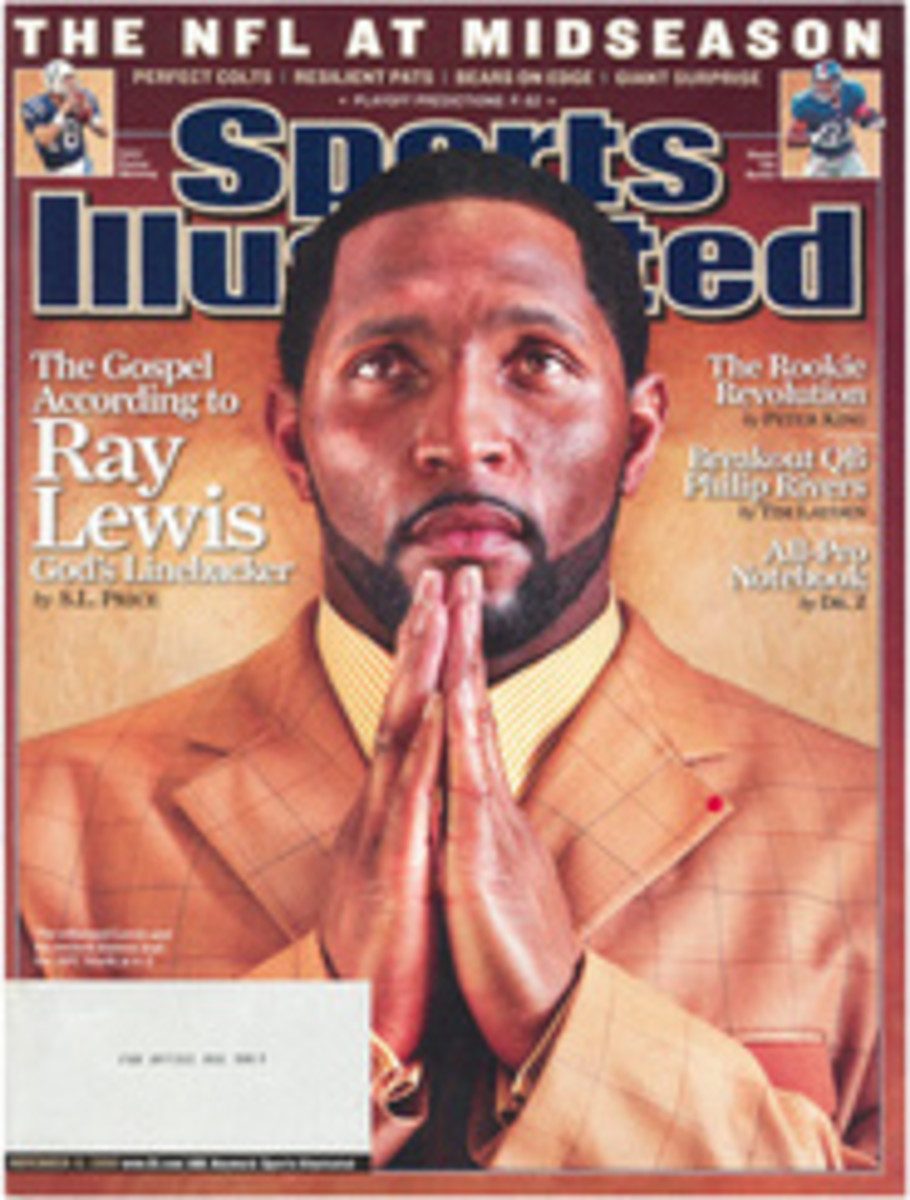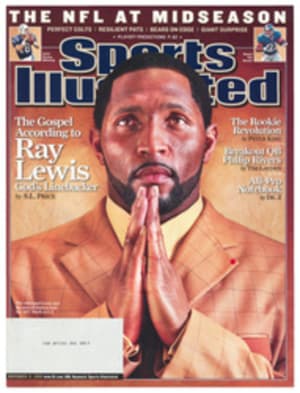
Bear Necessity
Roberto Garzalines the tools of his trade along a narrow table: helmet, shoulder pads, thighand knee pads, gloves, cleats, football pants and jersey. He is here on his offday, in the room at the Chicago Bears' practice facility where the offensiveline usually meets, to tape his weekly segment for Chicago's Telemundoaffiliate. The piece, in which he explains the basics of American football toTelemundo's Spanish-speaking audience, is called Yarda por Yarda con RobertoGarza.
"Ready?" asks Garza.
"Ready," says the cameraman, who turns on his camera light and beginsrolling. Garza stares at the camera and freezes.
Then he breaks uplaughing. Perhaps he was not so ready after all.
Oscar Guzmàn, theTelemundo sports anchor who is producing the shoot, smiles. "The bloopersare the best part," Guzmàn says. "We have lots of bloopers."
It's easy forGarza to laugh these days. The Bears are off to their best start since theirSuper Bowl season of 1985. The afternoon before, Chicago had dominated theBuffalo Bills 40--7, and he had played well. On pass plays Garza stood up theBills' defensive tackles, giving quarterback Rex Grossman plenty of time tothrow. On running plays he often paved the way, opening holes for running backsThomas Jones and Cedric Benson.
But tell the27-year-old right guard that he played well, and he's likely to argue thepoint. Garza is always thinking about the little things he could have donebetter. In football big men hit other big men, but first they must mastercomplicated schemes. The bewildering diagrams and jargon scrawled on thewhiteboards in the linemen's meeting room are a reminder of thatcomplexity.
But for all ofGarza's intricate knowledge of football, his lesson this week on Yarda porYarda couldn't be more basic. He is explaining the equipment he wears and whyhe wears it.
"Our viewers,some have been here [in the U.S.] two years, some two weeks," Guzman says."They don't know this game." Garza and Guzman came up with the idea ofdoing these tutorials over a get-to-know-you dinner last year. It makes sensebecause Garza is the perfect person to introduce the NFL to the Telemundoaudience. A son of Mexican immigrants, he was drawn to football before he evenknew what it was.
Garza grew up inRio Hondo, a town of about 2,000 in the southern tip of Texas, just 20 minutesnorth of the Mexican border. His parents, Roberto and Ofelia, had emigratedfrom Mexico just after they were married and settled in Rio Hondo becauseRoberto already had family living there. A year after they arrived, they hadtheir first of four children, Roberto Jr.
The elder Robertodrove a tractor and Ofelia worked as a janitor. The family lived just down thestreet from Rio Hondo High. Their house was close enough that Roberto Jr. couldhear the roars and see the lights that illuminated the night sky on fallFridays. He was fascinated even before he understood what was causing all thecommotion.
Soon he learned.Garza's uncle Juan was a fan of American football; he would come over onSundays to watch Dallas Cowboys games on television, and when his nephew wassix he started taking Roberto to the high school on Friday nights to watch thegames through a chain link fence. "I was mesmerized," Garza says.
He soon beganplaying football in the street with his cousins, and in seventh grade he playedhis first organized ball at school. "The first time I played on a practicefield, I was like, Man, this is what I want to do," Garza says. He lovedthe idea of working with so many teammates. "The big draw to me was being apart of something," he says. It didn't hurt that Garza was good. Already6'1" and 170 pounds, he started at fullback in his first year of juniorhigh and at tailback the following season. At Rio Hondo High, he moved to theoffensive and defensive lines, starting on the varsity as a freshman. "Thathappens when you play on a team with 30 people on it," he says.
Those summers inhigh school, Garza would work the local cotton harvest, operating a machinethat stamped down the cotton and packaged it. His schedule was brutal: Heworked seven days a week, starting at 8 a.m. and sometimes not finishing until1 a.m. He would often work 100 hours in a week. The pay was $5 an hour, withnothing extra for overtime. He learned a valuable lesson: Become good atsomething else. "I can't do this for the rest of my life," he recallstelling his cousin Humberto, who worked alongside him. "I have to go tocollege and try to find a better way to live."
Garza committedhimself to football with the same doggedness that got him through the summersbaling cotton. He went to the weight room every day during the school year. Hedidn't get any scholarship offers, but he did get an invitation to walk on atTexas A&M--Kingsville, 100 miles from Rio Hondo. Though just a Division IIschool, Kingsville has a history of producing NFL players, including suchgreats as Gene Upshaw, Darrell Green and John Randle. Garza won a starting jobby the end of his freshman year, in 1997. Jaime Hernandez, then a studentassistant and now the Javelinas' offensive line coach, recalls that he wasn'tparticularly impressed with the quiet freshman's size or physical gifts, but hedid note how Garza was always the first one in the weight room and never neededto be pushed about learning the playbook. "I couldn't tell you we sat thereand said, 'He's going to make it to the NFL,'" Hernandez says, "but weknew if he kept working like that he would have at least a chance."
Garza prosperedat Kingsville. He met his future wife, Ashley, a volleyball player. As a seniorhe was a Little All-America. In the spring of his junior year, he competed intrack and field, winning an NCAA championship in the shot put. Rio Hondodeclared Dec. 2, 2000, to be Roberto Garza Day and threw a parade in his honor.Garza rode down the main drag--all five or six blocks of it--in a convertiblewith his mother and father, part of a procession that included floats and firetrucks and the high school marching band. "It was surreal," Garza says.And with NFL scouts talking to him, he sensed this parade might never end.
Garza wasselected in the fourth round of the 2001 draft by the Atlanta Falcons and spenthis first three years mostly as a reserve before becoming a starter in 2004.That year the Falcons' running game blossomed, and Atlanta reached the NFCChampionship Game.
A free agent atthe conclusion of the season, he should have been in a position to reap therewards of that success, and at first it appeared he would. The BaltimoreRavens made a three-year, $7 million offer. But then a physical revealed thatGarza had no ACL in his right knee, the result of knee surgery the previousyear. Concerned about Garza's durability, the Ravens withdrew their offer.
Interest fromother teams waned, and Garza worried that he might never play again. Then ChrisBallard, a former Kingsville assistant who was working as a Bears scout, put ina good word with Chicago. Bears offensive line coach Harry Hiestand reviewedtape of Garza and saw that the missing ACL didn't seem to limit him on thefield. The Bears signed Garza to a one-year, low-risk deal for $596,160. In2005, playing with a knee brace, Garza was impressive while appearing in all 16games, starting seven. Last January the Bears signed him to a six-year, $13million contract that included a $4 million signing bonus. Asked why the teamfelt comfortable investing in Garza, Hiestand says, "It's pretty simple.He's a guy you can count on every day. He comes to work."
The NFL is themost popular league in America, but of its nearly 1,700 players, only a coupleof dozen are Latin American. Garza has accepted his role as one of the game'sLatino ambassadors, and it goes well beyond the tapings of Yarda por Yarda.Most prominently, Garza served as a spokesman for United Way, appearing incommercials that air in both Spanish and English. On Cinco de Mayo in recentyears he has been a guest of President Bush's at the White House and a grandmarshall at Chicago's parade. He often speaks to Hispanic youth, and last yearhe put on an event at a Chicago YMCA called F√∫tbol Americano con Roberto, askills clinic attended by 200 children. "I'm not trying to be an idol,"says Garza, "just somebody the kids can look to and say, 'He did it, I cando it as well.'"
The demand forpublic appearances is only going to go up because of the feverish interest inthe Bears' 7--1 start, for which Garza and his linemates deserve much of thecredit. They have kept Grossman upright after his last two seasons werederailed by injury, and that must continue if the Bears expect the good timesto keep rolling. "The feeling we have here in Chicago, it's hard to compareto any other feeling," Garza says. "I think what's special aboutChicago is that the Bears have been here since 1920. There have beengenerations of people following the Bears. This is a Bears town. They lovetheir Cubs and their Sox and they obviously love the Bulls, but when you getright down to it they love the Chicago Bears."
The feeling ismutual for Garza. After five years of living in apartments, he and Ashleybought their first house, in suburban Libertyville, not far from the Bears'practice facility. With Chicago as his adopted home, he often has occasion tosend packages to his father, and therein lies a problem. A few years ago RioHondo decided to further honor its native son by changing the name of thestreet where his parents live to Roberto Garza Drive. That means that whenGarza sends a FedEx home, the employee behind the counter sees the same wordsunder Recipient's Name, Recipient's Address and Sender and is sure the form hasbeen filled out incorrectly. So Garza has to explain who he is, where he camefrom and how he got here. It's a story he never tires of telling.
Holding theLine
In 2004 the Bearsgave up an NFL-high 66 sacks. Last year they cut that total to 31. And throughOct. 30 no team had been better at protecting its starting quarterback thisseason (minimum 190 attempts).
QUARTERBACK, TEAM | PASS ATT. | TIMES SACKED |
REX GROSSMAN, Bears | 218 | 6 |
PEYTON MANNING, Colts | 245 | 7 |
DREW BREES, Saints | 252 | 8 |
BRETT FAVRE, Packers | 263 | 9 |
PHILIP RIVERS, Chargers | 210 | 10 |
JAKE PLUMMER, Broncos | 190 | 10 |
my SI
DOWNLOAD FREE
Bears fan? Get news about your team from across the Web on your desktop atSI.com/mySI.
"I have to go to college and find A BETTER WAY TOLIVE," Garza recalls saying during long days working the cottonharvest.
TWO PHOTOS
Photographs by John Biever
COMMONGROUND
One of the NFL's few Latin players, Garza has always enjoyed the feeling ofcommunity in football.
PHOTO
JEFF ROBERSON/AP
BLOCKPARTY
Garza (63) and his linemates are leading the way for a team that is averaging29.3 points a game.
PHOTO
TOM DAHLIN
STANDING GUARD
Garza & Co. have excelled at keeping the injury-prone Grossman (8) out ofharm's way.

